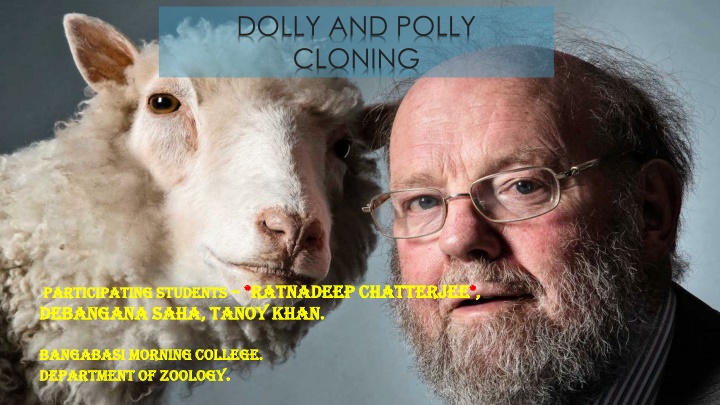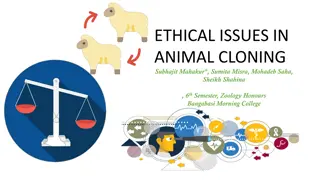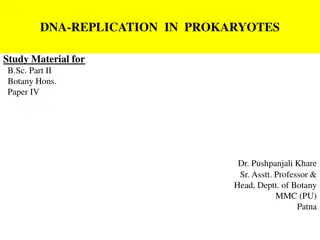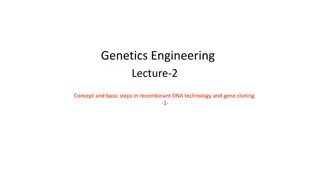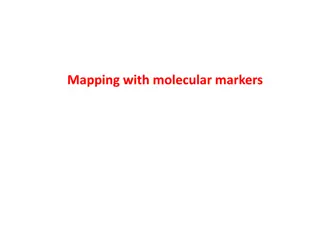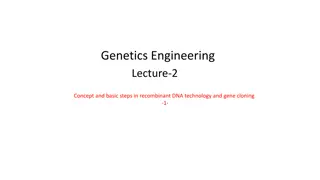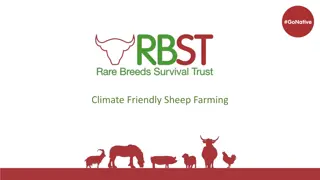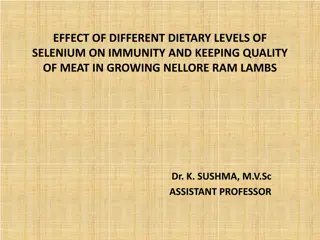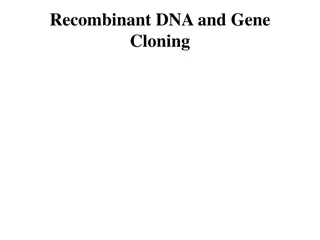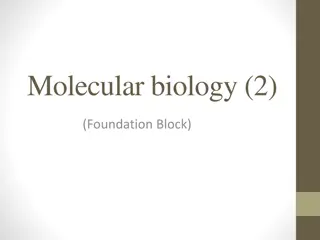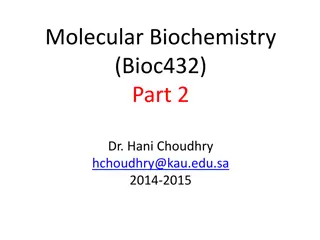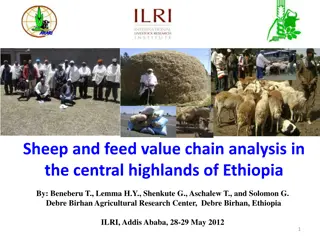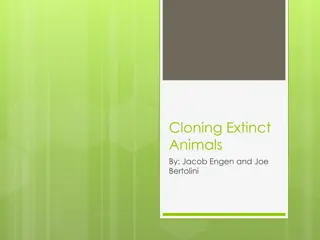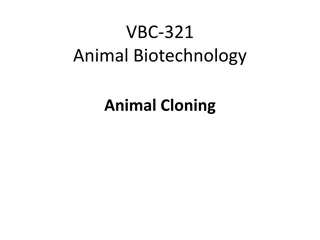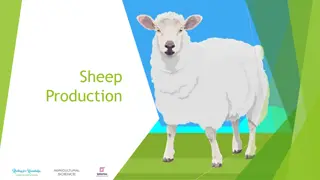The Fascinating World of Cloning: From Dolly the Sheep to Genetic Replication Techniques
Cloning is the process of creating genetically identical organisms, either naturally or artificially. This article delves into the various techniques of cloning such as gene cloning, reproductive cloning, and therapeutic cloning. It also highlights the groundbreaking story of Dolly the sheep, the first mammal cloned from an adult somatic cell. Learn about the innovative processes involved in cloning and its impact on scientific research and advancements.
Download Presentation

Please find below an Image/Link to download the presentation.
The content on the website is provided AS IS for your information and personal use only. It may not be sold, licensed, or shared on other websites without obtaining consent from the author.If you encounter any issues during the download, it is possible that the publisher has removed the file from their server.
You are allowed to download the files provided on this website for personal or commercial use, subject to the condition that they are used lawfully. All files are the property of their respective owners.
The content on the website is provided AS IS for your information and personal use only. It may not be sold, licensed, or shared on other websites without obtaining consent from the author.
E N D
Presentation Transcript
DOLLY AND POLLY CLONING PARTICIPATING STUDENTS PARTICIPATING STUDENTS * *RATNADEEP CHATTERJEE RATNADEEP CHATTERJEE* *, , DEBANGANA SAHA, TANOY KHAN. DEBANGANA SAHA, TANOY KHAN. BANGABASI MORNING COLLEGE. BANGABASI MORNING COLLEGE. DEPARTMENT OF ZOOLOGY DEPARTMENT OF ZOOLOGY. .
INTRODUCTION The process of producing genetically identical individuals of an organism either naturally or artificially is called cloning. There are several techniques for cloning such as Gene cloning, Reproductive cloning, and Therapeutic cloning. Gene cloning involves copying a specific gene and inserting it into a host organism. Reproductive cloning involves creating a genetically identical copy of an entire organism by transferring its genetic material into an egg cell. Therapeutic cloning involves creating Embryonic Stem cells for medical research and treatment purposes. Coined by Herbert J. Webber, the term Clone derives from the ancient Greek word klon , which is the process whereby a new plant is created from a twig.
A look back at how a Scottish sheep changed the world of science. It was the 5th of July, 1996 that Dolly, the sheep was born, the ultimate product of a series of cloning experiments that would soon rock the research world. Her birth, reported the following year in Nature , made Dolly and the scientists who created her instant celebrities.
Dolly was the first mammal successfully cloned from an adult somatic cell rather than an embryonic cell. British development biologist, Sir Ian Wilmut and his colleagues of the Roslin Institute, near Edinburgh, Scotland was responsible for this cloning. They had concentrated on developing the technology using sheep because sheep in Scotland are very, very, very cheap.
The marvellous Process that gave birth to dolly. I. Enucleating the eggs produced by Scottish Blackface Ewes (female sheep) :- The ewes were treated with Gonadotropin- Releasing Hormone (GnRH) to cause them to produce oocytes ready to be fertilized. A micropipette is then plunged into the egg over the polar body and the polar body along with the haploid pronucleus is sucked out from within the egg.
II. Each enucleated egg is fused with a diploid cell growing in culture :- Cells from the mammary gland of an adult Finn Dorset ewe (they have white faces) were grown in tissue culture. Five days before use, the nutrient level in the culture was reduced so that the cells stop dividing and enter into G0 of the cell cycle. Donor cells and enucleated recipient cells were placed together in culture. The cultures were exposed to pulses of electricity to - Cause their respective plasma membranes to fuse; Stimulate the resulting cell to begin mitosis (by mimicking the stimulus of fertilization).
III. The cells were then cultured until they have grown into a morula (solid mass of cells) or even into a blastocyst (6 days). IV. Several of these were transferred into the uterus of each (of 13, in this case) Scottish Blackface ewes (previously treated with GnRH to prepare them for implantation). V. Now, with their fingers crossed, the scientists waited for the result. RESULT :- One ewe gave birth (148 days later) to Dolly.
When Dolly was one year old, analysis of her DNA showed that her telomeres were shorter than would be expected for a normal sheep of the same age. Telomeres are caps on the ends of DNA molecules that protect the DNA from damage. As an animal or person ages, their telomeres become progressively shorter, exposing the DNA to more damage. It s thought that Dolly had shorter telomeres were because her DNA came from an adult sheep and the telomeres had not been fully renewed during her development. This could have meant that Dolly was older than her actual age.
How do we know that Dolly is not the progeny of an unsuspected mating of the foster mother ? Did the scientists at Roslin institute fool us ? Well, the answer to this question is NO. They didn t fool us. She had a white face but the foster mother was a Scottish Blackface, which means they didn t resemble to each other. DNA fingerprinting of Dolly reveals bands found in Finn Dorset sheep (the breed that supplied the mammalian cells), not those of Scottish Blackface sheep.
look whos born, its look who s born, it s polly polly the sheep ! the sheep ! Less than a year after the creation of Dolly, Wilmut and his team created the transgenic lamb Polly, combining animal and human genetic material and utilizing the embryo splitting technique. Polly was born in 1997. Polly was a Poll Dorset clone made from nuclear transfer using a fetal fibroblast nucleus genetically engineered to express a human gene known as FIX . This gene encodes a substance called Human Factor IX, a clotting factor that occurs naturally in most people but that is absent in people with Hemophilia, who require replacement therapy with a therapeutic form of the substance.
whats the difference? Just d and P? There are substantial differences between the two experiments: a) Dolly has the same nuclear DNA as the donor ewe, while Polly contains part of the DNA from the donor ewe and part from human DNA; b) Dolly was 'cloned' from specialized adult cells, while Polly was created from embryonic stem cells. Polly is aimed at producing a line capable of supplying milk containing 1-antitrypsin, a human plasma protein used in the treatment of cystic fibrosis, thereby opening the way for the large-scale, low-cost production of other human proteins.
Ethical issues Ethical issues While their creation was a major scientific achievement, it also raised several ethical concerns, including : I. Animal welfare Dolly s cloning was achieved after multiple failed attempts, which raises ethical concerns, regarding animal welfare. Animals used in scientific research should not be subjected to unnecessary pain or suffering. II. Potential to Human Cloning The successful cloning of Dolly raised fears that it could open the door to human cloning. The prospect of cloning humans raises a host of ethical, legal, and social concerns, such as questions about the safety of the cloning process and concerns about the commodification of human life. III. Potential genetic abnormalities Dolly s creation raised concerns about the possibility of genetic abnormalities in cloned animals. In fact, Dolly died at the age of six due to a lung disease that is common in older sheep, but which typically does not affect sheep of her age.
CONCLUSION The birth of Dolly the sheep through somatic cell nuclear transfer (SCNT) was a significant milestone in the field of genetics and reproductive biology. It proved that adult cells could be reprogrammed to a state where they could produce a fully formed animal, and it opened up new possibilities for genetic research and animal breeding. However, Dolly's birth also raised ethical questions about the safety and morality of cloning. Concerns were raised about the potential health risks to cloned animals and the possibility of cloning humans, which could lead to a host of ethical and social issues. Since Dolly's birth in 1996, significant progress has been made in the field of SCNT, including the cloning of other mammals such as cats, dogs, and horses. However, cloning remains a controversial and complex issue, and the long-term effects of cloning on animal health and welfare are still being studied. Where is Dolly now? Ans. After her death, the Roslin Institute donated Dolly s body to the National Museum of Scotland in Edinburgh, where she has become one of the museum s most popular exhibits.
REFERENCE CAMPBELL, K. H. S.; McWHIR, J.; RITCHIE, W. A. & WILMUT, I., 1996. Sheep cloned by nuclear transfer from cultured cell line. Nature, 380:64-66. KLOTZKO, A. J. J. D., 1997. A report from America. The debate about Dolly. Bioethics, 11:427-438. WILMUT, I., 1997. One small step for a sheep. New Scientist, 2071:4. www.sciencedirect.com https://www.researchgate.net https://Britannica.com https://dbpedia.org/page/Polly_and_Molly https://www.irishtimes.com/news/cloned-polly-the-lamb-carries-human-genes-1.91523 https://www.jstor.org/stable/30301616 https://www.usnews.com/news/national-news/articles/2017-02-22/20-years-after-dolly-everything-you-want-to-know-about-the-cloned-sheep U.S. National Bioethics Advisory Committee. 6 June 1997. "Cloning Human Beings." ,Washington, DC. Winston, R. 1997. "The Promise of Cloning for Human Medicine." British Medical Journal, 314:7085.
ACKNOWLEDGEMENT We would like to take this opportunity to acknowledge everyone who has helped me in every stage of this presentation. We are deeply thankful and wish to express my sincere gratitude to our respected Principal Dr. Amitava Dutta Sir. We are sincerely thankful and wish to express my gratitude towards our teacher Dr. Sreejata Biswas ma am (Department of zoology) for her guidance to do this presentation on Dolly and Polly Cloning. Her useful advice and suggestions were really helpful to us during the presentation s completion. In this aspect, we are grateful to her. I d like to express my gratitude to my friends and my partners for their constant support and help. Without them it would have been quite a tough challenge for me, but their presence made it quite easy and interesting. Last but not the least, I would also like to acknowledge the endless contributions of my parents who always encourage me.
